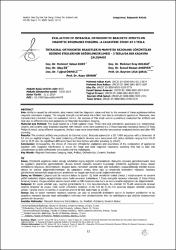Evaluation of intraoral orthodontic brackets’ effects on magnetic resonance imaging –A cadaveric study at 3 tesla

View/
Access
info:eu-repo/semantics/openAccessDate
2020Author
Kurt, Mehmet HakanKolsuz, Mehmet Eray
Öz, Ulaş
Avsever, İsmail Hakan
Örmeci, Tuğrul
Şakul, Bayram Ufuk
Orhan, Kaan
Metadata
Show full item recordCitation
Kurt, M. H., Kolsuz, M. E., Öz, U., Avsever, İ. H., Örmeci, T., Şakul, B. U. ... Orhan, K. (2020). Evaluation of intraoral orthodontic brackets’ effects on magnetic resonance imaging –A cadaveric study at 3 tesla. The Journal of Faculty of Dentistry of Atatürk University, 30(1), 12-19. https://doi.org/10.17567/ataunidfd.649475Abstract
Aim: Artifacts caused by orthodontic attachments limit the diagnostic value and lead to the removal of these appliances before magnetic resonance imaging. The magnet strength can influence the artifact size due to orthodontic appliances. Moreover, new (ceramic/clear) brackets have not evaluated. Hence, the purpose of this study was to quantitively evaluated the artifacts and heat due to different intra-oral appliances on Magnetic Resonance Imaging. Material and Method: The study based on a fresh cadaver head. Three intra-oral orthodontic appliances (i.e. metal/metalceramic and ceramic clear brackets) together with metallic wires were scanned in a 3 Tesla magnetic resonance device (3-Tesla Philips Achieva) using different sequences. Artifact areas were determined and the temperature evaluated before and after MRI scanning. Results: The smallest artifact was produced by Ceramic (clear) Brackets scanned in a 3D FLAIR sequence with a dimension of 9,1 mm on sagittal images. The steel-containing orthodontic devices were associated with radius artifacts ranging from 34,45 mm to 47,35 mm. No significant difference found for heat before and after scanning (p ≤0.05). Conclusion: Consequently, the choice of intra-oral orthodontic appliances and awareness of the composition of appliances together with magnetic interference is crucial for head and neck magnetic resonance scanning that has to take into consideration by both orthodontic consultants and the radiologists. Amaç: Ortodontik aygıtların neden olduğu artefaktlar teşhis değerini kısıtlamaktadır. Manyetik rezonans görüntülemeden önce bu aygıtların çıkarılması gerekmektedir. Bunula birlikte manyetik kuvvetin büyüklüğü ortodontik aygıtlardan dolayı oluşan artefaktalrın boyutunu etkilemektedir. Bugüne kadar, tamamen seramik olan yeni braketlerin oluşturabileceği artefakt boyutu detaylı bir şekilde değerlendirilmemiştir. Bu çalışmanın amacı, farklı ağız içi ortodontik braketlerin manyetik rezonans görüntüleme esnasındaki oluşturdukları artefaktları ve oluşan ısıyı nicel olarak değerlendirmektir. Gereç ve Yöntem: Çalışma taze bir kadavra kafası ile yapıldı. Üç farklı ortodontik braket (metal / metal-seramik ve seramik şeffaf braketler) dişlere yapıştırıldıktan sonra farklı sekanslar kullanılarak 3 Tesla manyetik rezonans cihazında (3 Tesla Philips Achieva) tarandı. Oluşan artefakt alanları tespit edildi ve MRI taramasından önce ve sonra sıcaklık değişimleri de değerlendirildi. Bulgular: En küçük artefakt çapı, sagittal görüntülerde 9,1 mm boyutlarındaydı. Bu artefakt 3D FLAIR sekansında taranan seramik braketler ile oluştu. Çelik içeren ortodontik braketler 34,45 mm ila 47,35 mm arasında değişen artefakt çaplarına sahipti. Tarama öncesi ve sonrası ısı açısından anlamlı bir fark bulunmadı (p ≤0.05). Sonuç: Baş ve boyun manyetik rezonans taraması için ağız içi ortodontik braketlerin seçimi ile bunların içeriklerinin ve bu aygıtların manyetik alandan nasıl etkilendiğinin bilinmesi hem ortodontistlerin hem de radyologların göz önünde bulundurması gereken bir durumdur.
Source
The Journal of Faculty of Dentistry of Atatürk UniversityVolume
30Issue
1Collections
- Makale Koleksiyonu [3649]
- TR-Dizin İndeksli Yayınlar Koleksiyonu [2175]

















